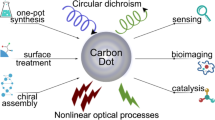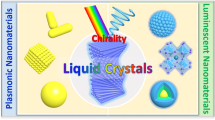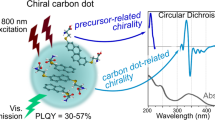Abstract
Chiral quantum dots (QDs) are expected to have a range of potential applications in photocatalysis, as specific antibacterial and cytotoxic drug-delivery agents, in assays, as sensors in asymmetric synthesis and enantioseparation, and as fluorescent chiral nanoprobes in biomedical and analytical technologies. In this protocol, we present procedures for the synthesis of chiral optically active QD nanostructures and their quality control using spectroscopic studies and transmission electron microscopy imaging. We closely examine various synthetic routes for the preparation of chiral CdS, CdSe, CdTe and doped ZnS QDs, as well as of chiral CdS nanotetrapods. Most of these nanomaterials can be produced by a very fast (70 s) microwave-induced heating of the corresponding precursors in the presence of D- or L-chiral stabilizing coating ligands (stabilizers), which are crucial to generating optically active chiral QDs. Alternatively, chiral QDs can also be produced via the conventional hot injection technique, followed by a phase transfer in the presence of an appropriate chiral stabilizer. We demonstrate that the properties, structure and behavior of chiral QD nanostructures, as determined by various spectroscopic techniques, strongly depend on chiral stabilizers and that the chiral effects induced by them can be controlled via synthetic procedures.
This is a preview of subscription content, access via your institution
Access options
Subscribe to this journal
Receive 12 print issues and online access
$259.00 per year
only $21.58 per issue
Buy this article
- Purchase on Springer Link
- Instant access to full article PDF
Prices may be subject to local taxes which are calculated during checkout














Similar content being viewed by others
References
Ben-Moshe, A., Maoz, B.M., Govorov, A.O. & Markovich, G. Chirality and chiroptical effects in inorganic nanocrystal systems with plasmon and exciton resonances. Chem. Soc. Rev. 42, 7028–7041 (2013).
Govorov, A.O. et al. Chiral nanoparticle assemblies: circular dichroism, plasmonic interactions, and exciton effects. J. Mater. Chem. 21, 16806–16818 (2011).
Guerrero-Martinez, A., Lorenzo Alonso-Gomez, J., Auguie, B., Magdalena Cid, M. & Liz-Marzan, L.M. From individual to collective chirality in metal nanoparticles. Nano Today 6, 381–400 (2011).
Wang, Y., Xu, J., Wang, Y. & Chen, H. Emerging chirality in nanoscience. Chem. Soc. Rev. 42, 2930–2962 (2013).
Wang, J., Liu, S., Zhang, C., Xu, H. & Yang, X. Synthesis and applications of chiral nano-silica. Prog. Chem. 23, 669–678 (2011).
Liu, H., Shen, X., Wang, Z.-G., Kuzyk, A. & Ding, B. Helical nanostructures based on DNA self-assembly. Nanoscale 6, 9331–9338 (2014).
Ben-Moshe, A. et al. Enantioselective control of lattice and shape chirality in inorganic nanostructures using chiral biomolecules. Nat. Commun. 5, 430 (2014).
Yeom, B. et al. Chiral plasmonic nanostructures on achiral nanopillars. Nano Lett. 13, 5277–5283 (2013).
Gerard, V.A., Gun'ko, Y.K., Defrancq, E. & Govorov, A.O. Plasmon-induced CD response of oligonucleotide-conjugated metal nanoparticles. Chem. Commun. 47, 7383–7385 (2011).
Zhao, Y. et al. Alternating plasmonic nanoparticle heterochains made by polymerase chain reaction and their optical properties. J. Phys. Chem. Lett. 4, 641–647 (2013).
Song, L., Wang, S., Kotov, N.A. & Xia, Y. Nonexclusive fluorescent sensing for L/Denantiomers enabled by dynamic nanoparticle-nanorod assemblies. Anal. Chem. 84, 7330–7335 (2012).
Moloney, M.P., Gun'ko, Y.K. & Kelly, J.M. Chiral highly luminescent CdS quantum dots. Chem. Commun. 2007, 3900–3902 (2007).
Elliott, S.D., Moloney, M.P. & Gun'ko, Y.K. Chiral shells and achiral cores in CdS quantum dots. Nano Lett. 8, 2452–2457 (2008).
Gallagher, S.A. et al. Synthesis and spectroscopic studies of chiral CdSe quantum dots. J. Mater. Chem. 20, 8350–8355 (2010).
Moloney, M.P., Gallagher, S.A. & Gun'ko, Y.K. Chiral CdTe quantum dots. MRS Proceedings 1241 http://dx.doi.org/10.1557/PROC-1241-XX02-10 (2009).
Gerard, V.A., Freeley, M., Defrancq, E., Fedorov, A.V. & Gun'ko, Y.K. Optical properties and in vitro biological studies of oligonucleotide-modified quantum dots. J. Nanomater. 2013 http://dx.doi.org/10.1155/2013/463951 (2013).
Govan, J.E., Jan, E., Querejeta, A., Kotov, N.A. & Gun'ko, Y.K. Chiral luminescent CdS nano-tetrapods. Chem. Commun. 46, 6072–6074 (2010).
Xia, Y., Zhou, Y. & Tang, Z. Chiral inorganic nanoparticles: origin, optical properties and bioapplications. Nanoscale 3, 1374–1382 (2011).
Nakashima, T., Kobayashi, Y. & Kawai, T. Optical activity and chiral memory of thiol-capped CdTe nanocrystals. J. Am. Chem. Soc. 131, 10342–10343 (2009).
Zhou, Y., Yang, M., Sun, K., Tang, Z. & Kotov, N.A. Similar topological origin of chiral centers in organic and nanoscale inorganic structures: effect of stabilizer chirality on optical isomerism and growth of CdTe nanocrystals. J. Am. Chem. Soc. 132, 6006–6013 (2010).
Tohgha, U. et al. Ligand induced circular dichroism and circularly polarized luminescence in CdSe quantum dots. ACS Nano 7, 11094–11102 (2013).
Tohgha, U., Varga, K. & Balaz, M. Achiral CdSe quantum dots exhibit optical activity in the visible region upon post-synthetic ligand exchange with D- or L-cysteine. Chem. Commun. 49, 1844–1846 (2013).
Gun'ko, Y.K., Moloney, M.M., Gallagher, S., Govan, J. & Hanley, C. New quantum dot sensors. SPIE 7679 http://dx.doi.org/10.1155/2013/463951 (2010).
Carrillo-Carrion, C., Cardenas, S., Simonet, B.M. & Valcarcel, M. Selective quantification of carnitine enantiomers using chiral cysteine-capped CdSe(ZnS) quantum dots. Anal. Chem. 81, 4730–4733 (2009).
Delgado-Pérez, T., Bouchet, L.M., de la Guardia, M., Galian, R.E. & Pérez-Prieto, J. Sensing chiral drugs by using CdSe/ZnS nanoparticles capped with N-acetyl-L-cysteine methyl ester. Chemistry 19, 11068–11076 (2013).
Shah, E. & Soni, H.P. Inducing chirality on ZnS nanoparticles for asymmetric aldol condensation reactions. RSC Adv. 3, 17453–17461 (2013).
Zhu, Z. et al. Controllable optical activity of gold nanorod and chiral quantum dot assemblies. Angew. Chem. Int. Ed. 52, 13571–13575 (2013).
Chen, M. et al. Synthesis of rod-, twinrod-, and tetrapod-shaped CdS nanocrystals using a highly oriented solvothermal recrystallization technique. J. Mater. Chem. 12, 748–753 (2002).
Fiore, A. et al. Tetrapod-shaped colloidal nanocrystals of II:VI semiconductors prepared by seeded growth. J. Am. Chem. Soc. 131, 2274–2282 (2009).
Pang, Q. et al. CdSe nano-tetrapods: controllable synthesis, structure analysis, and electronic and optical properties. Chem. Mater. 17, 5263–5267 (2005).
Xie, R.G., Kolb, U. & Basche, T. Design and synthesis of colloidal nanocrystal heterostructures with tetrapod morphology. Small 2, 1454–1457 (2006).
Zhang, J.Y. & Yu, W.W. Formation of CdTe nanostructures with dot, rod, and tetrapod shapes. Appl. Phys. Lett. 89, 3 (2006).
Gaponik, N. et al. Thiol-capping of CdTe nanocrystals: an alternative to organometallic synthetic routes. J. Phys. Chem. B 106, 7177–7185 (2002).
Raevskaya, A.E. et al. Growth and spectroscopic characterization of CdSe nanoparticles synthesized from CdCl2 and Na2SeSO3 in aqueous gelatine solutions. Colloids Surf. A 290, 304–309 (2006).
Yang, Y.J. & Xiang, B.J. Wet synthesis of nearly monodisperse CdSe nanoparticles at room temperature. J. Cryst. Growth 284, 453–458 (2005).
Bhuse, V.M., Hankare, P.P., Garadkar, K.M. & Khomane, A.S. A simple, convenient, low-temperature route to grow polycrystalline copper selenide thin films. Mater. Chem. Phys. 80, 82–88 (2003).
He, Y. et al. Synthesis of CdTe nanocrystals through program process of microwave irradiation. J. Phys. Chem. B 110, 13352–13356 (2006).
He, Y. et al. Microwave-assisted synthesis of water-dispersed CdTe nanocrystals with high luminescent efficiency and narrow size distribution. Chem. Mater. 19, 359–365 (2007).
Bao, H. One-pot synthesis of CdTe nanocrystals and shape control of luminescent CdTe-cystine nanocomposites. Small 2, 476–480 (2006).
Yu, W.W. & Peng, X.G. Formation of high-quality CdS and other II–VI semiconductor nanocrystals in noncoordinating solvents: tunable reactivity of monomers. Angew. Chem. Int. Ed. 41, 2368–2371 (2002).
Pan, Z. et al. Highly efficient inverted Type-I CdS/CdSe core/shell structure QD-sensitized solar cells. ACS Nano 6, 3982–3991 (2012).
Acknowledgements
This work was supported by Science Foundation Ireland (grant no. SFI 12/IA/1300), by a FP7 FutureNanoNeeds grant and by the Ministry of Education and Science of the Russian Federation (grant no. 14.B25.31.0002).
Author information
Authors and Affiliations
Contributions
M.P.M., J.G. and A.L. performed the synthesis and characterization of quantum nanostructures. M.M. performed phase-transfer studies of chiral nanostructures. M.P.M., J.G., A.L. and Y.K.G. developed the protocols and wrote the manuscript.
Corresponding author
Ethics declarations
Competing interests
The authors declare no competing financial interests.
Rights and permissions
About this article
Cite this article
Moloney, M., Govan, J., Loudon, A. et al. Preparation of chiral quantum dots. Nat Protoc 10, 558–573 (2015). https://doi.org/10.1038/nprot.2015.028
Published:
Issue Date:
DOI: https://doi.org/10.1038/nprot.2015.028
This article is cited by
-
Circularly Polarized Light-Enabled Chiral Nanomaterials: From Fabrication to Application
Nano-Micro Letters (2023)
-
Liquid crystal-templated chiral nanomaterials: from chiral plasmonics to circularly polarized luminescence
Light: Science & Applications (2022)
-
Ultrasound-assisted synthesis of chiral cysteine-capped CdSe quantum dots for fluorometric differentiation and quantitation of tryptophan enantiomers
Microchimica Acta (2020)
-
Gold Nanorods as Visual Sensing Platform for Chiral Recognition with Naked Eyes
Scientific Reports (2018)
-
Chiral nanoparticles in singular light fields
Scientific Reports (2017)
Comments
By submitting a comment you agree to abide by our Terms and Community Guidelines. If you find something abusive or that does not comply with our terms or guidelines please flag it as inappropriate.



